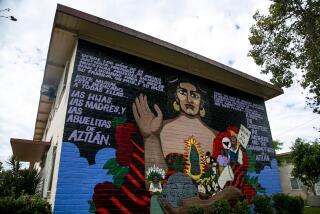Q&A: ‘Blaxicans of L.A.’: capturing two cultures in one
- Share via
When race in this country is often discussed in black and white, where do those who don’t quite fit the dime fall?
Walter Thompson-Hernandez, a researcher with the Center for the Study of Immigrant Integration at USC, is attempting to answer that question with the help of his full-frame Nikon camera.
Two years ago, he began a research project on “Blaxican” identity, interviewing individuals of African American and Mexican descent like himself. He thought it was important to share his research with audiences outside academia, so he started a project on Instagram called Blaxicans of L.A., capturing portraits of Blaxicans and their families.
“I think Blaxicans really have the capacity to make us think about racial coalitions in different ways,” he said.
For Thompson-Hernandez, Blaxicans in L.A. represent the future of this country’s ethnic landscape -- one with a broader spectrum of identities.
“They say by 2043, this will be a majority-minority country,” he said. “So I see Blaxicans as a 2043 fast-forward.”
Below, he tells the #SoCalMoments team about his experience documenting Blaxicans and the hopes he has for the project’s future.
What is it that drove you to manifest your research into a photo project?
I, more than anything, am a storyteller. And I do that through several mediums -- I do it through academic research, but I also really think about photos and the power of photography. Photos really have a special way of moving people. They are essentially a mirror to ourselves. So when people see these photos of Blaxicans of Los Angeles, I want them to think about their own racial experiences. We are all complex multitudes, of course. Photos just allow us to really engage with Blaxicans in way that academic research does not.
How did you get into photography?
I’ve always been into photography, but I had never owned a camera until recently. In 2012, I purchased a Nikon D600 with a 35mm lens. That lens really allows me to capture what the eye sees. I can take these photos with a wide enough angle that not only captures my subject, but also the environment they exist in.
If you notice, a lot of my photos have a background. I always ask people to meet me in places that best represent them -- their home, the beach or any other particular place in Los Angeles. If I were shooting with a closer lens -- say a 50mm -- I wouldn’t be able to really capture their environment. And I think our environments really impact who we are and sort of our identities, so I want capture that.
What are some struggles you’ve encountered?
One of my struggles is really understanding what to do with these stories. I’m in situations where people really open up about their family history, events that involve trauma -- some very personal matters. I’m put in a position where these people have really trusted me, and that comes with great responsibility. So what do I really do with these stories? What do I do with these photos? How do I position them in a way that not only honors and respects their individual experiences, but also those of their family and community? As a researcher -- and as a Blaxican -- I have to think about how to best frame these stories.
Why do you think these stories need more recognition?
I think Los Angeles, and the U.S. more broadly, really thinks about race in a really narrow and rigid way. We have a tendency to see race relations in a black and white dichotomy, even when we think about multiracial experiences. So where do Blaxicans fit in that equation? Where do we fit in this historically black and white racial binary?
The way I see it, Blaxicans really challenge the way we think about race and force us to think about racial identities in more inclusive and broad ways. Blaxicans are dual minorities. We represent two of the largest ethnic minority groups. And I think because Blaxicans represent two of the most aggrieved groups in Los Angeles, it’s important to understand that certain sets of issues and challenges that have been traditionally labeled as African American or Latino, ultimately, do not exist for people who self-identify as Blaxicans.
I’ve found that a large majority of my respondents feel that issues like mass deportation, the hyper-criminalization of black bodies and senseless murder of unarmed young black men, affect both sides of their families. You have relatives who are being held in detention centers and relatives who have been gunned down for the simple fact that they are black. In this sense, being a Blaxican is almost like a full time job. You don’t have the privilege of “looking the other way” when an injustice occurs because it probably affects you or your family in a very intimate way. This is a reality that you simply cannot escape. It’s important that this reality is recognized.
What do you want people to learn about the Blaxican experience?
I want people to understand the complexities of who Blaxicans are. These are folks who exist in a multitude of social and racial worlds. And there’s something really beautiful about that. There’s something special about you being able to sometimes seamlessly navigate different worlds -- whether they are racial, linguistic, culinary or musical. I think it’s something that people should really know more about.
Follow Ebony Bailey on Instagram and Twitter.
Each week, we’re featuring photos of Southern California and California submitted by readers. Share your photos on our Flickr page or tag your photos with #socalmoments or #californiamoments on Instagram and Twitter. Follow us on Twitter or visit latimes.com/socalmoments for more on this photo series.
More to Read
Sign up for Essential California
The most important California stories and recommendations in your inbox every morning.
You may occasionally receive promotional content from the Los Angeles Times.










